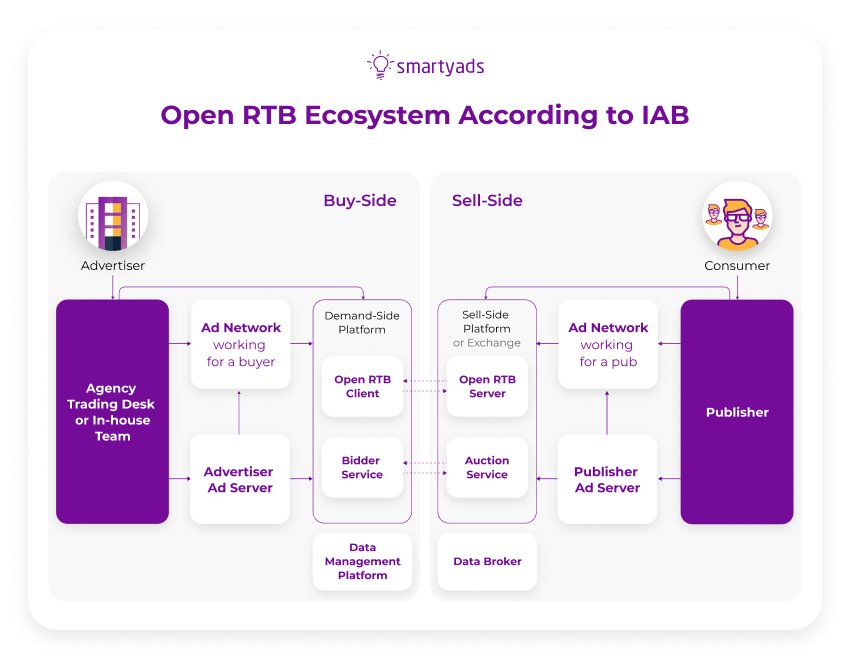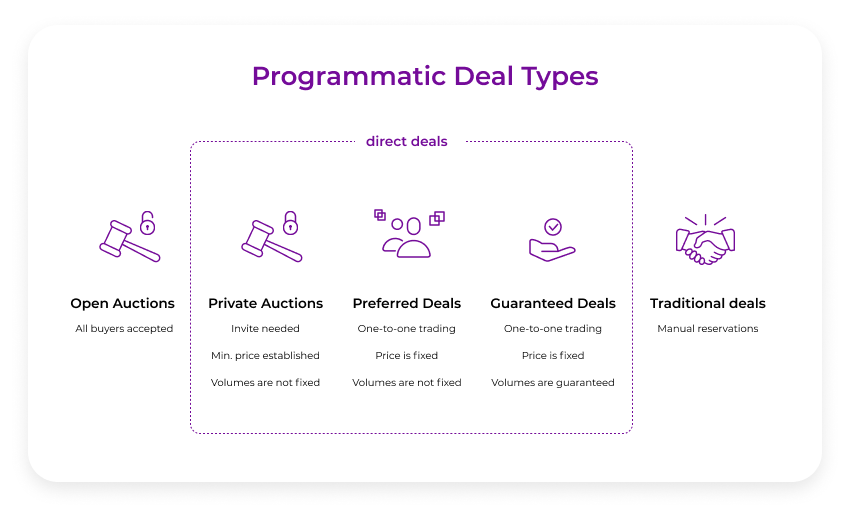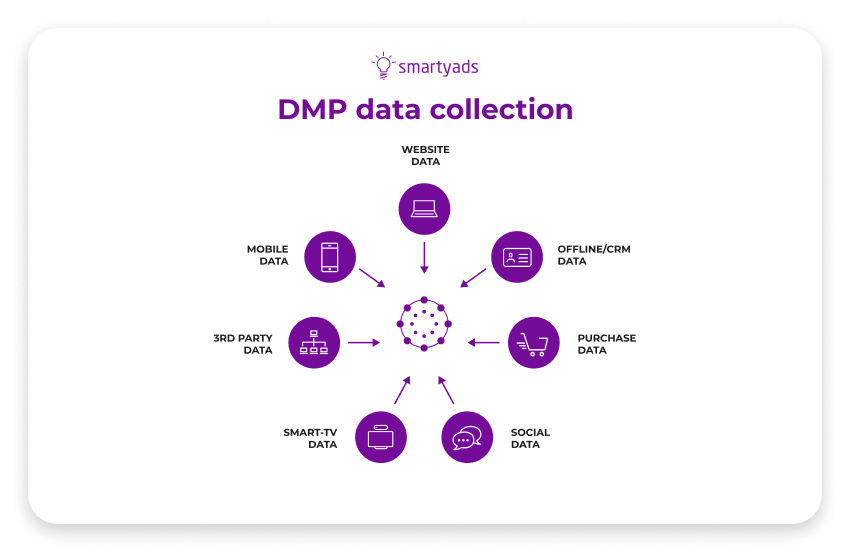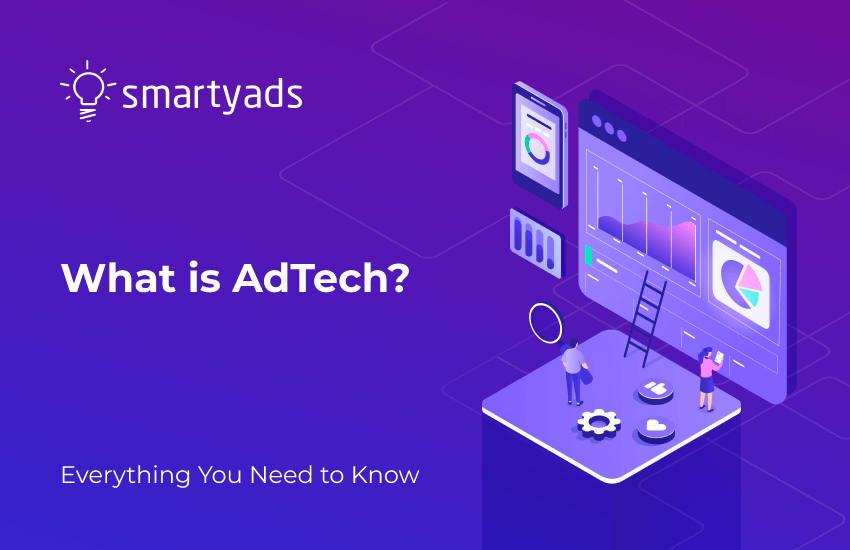The world of ad tech today is vastly different from what it looked like just a decade or even a few years ago. Back in the day, marketing was pretty straightforward — it often just involved a handshake deal between an advertiser and a publisher. But oh, how times have changed. Now, the way companies connect with their audience is nothing short of revolutionary, thanks in large part to the seismic shift brought about by the dawn of digital advertising technology. Every year, we see a flood of new ad tech solutions hitting the market, pushing marketers to continually up their game with more refined and sophisticated tools.
So, what’s the deal with the ad tech industry, and how does it actually work? Today, it’s almost impossible to stumble upon any ad on the web that isn’t backed by some kind of ad tech software. And really, it’s no surprise. With 74% of marketers leaning towards agencies that are adept at leveraging the full power of advertising ad tech technology, it’s clear that ad tech has become an indispensable part of the advertising world. The constant evolution and the depth of advertising technologies available today highlight just how pivotal ad tech has become in crafting the intricate and dynamic digital advertising world we navigate.

So, what is ad tech?
Ad tech (also sometimes spelled as adtech) is an umbrella term that stands for advertising technology. Ad tech includes all kinds of tools and software platforms that advertisers utilize to deliver their ads to potential customers. Publishers use advertising technology platforms to automate their inventory monetization with ads. Full-stack ad tech stack helps businesses plan and execute marketing strategies, from three stages of media-buying and selling to performing analysis and optimizing their advertising efforts. Ad tech software is at the core of the programmatic advertising industry. It facilitates targeted advertising, as well as omnichannel marketing strategies and many other advanced promotion techniques.
Both supply and demand sides significantly benefit from advertising technology, so media-traders need to know at least the basics of it to leverage its strong points.
Why do we need ad tech?
To answer this question let us dive a little bit into the past and remind how advertising was done before the ad tech industry was introduced and the programmatic ecosystem emerged. With the traditional ad placement approach, advertising messages were delivered to the viewers via as many different channels and spaces as possible. Such a strategy is not bad. Moreover, it can even be effective for some goals, like increasing brand awareness and getting exposure for the new businesses and products. However, such distribution of resources is far from perfect and will hardly give advertisers any sound results - ads broadcasted to the mass audiences tend to be less relevant to each specific viewer. They are hard to personalize which makes it almost impossible to build a real connection with the customer. As a result - lower ad performance and a huge waste of time and effort.
Luckily, with adtech meaning that modern advertisements are delivered to the most relevant audiences with the perfect timing and within the most suitable context. With their help, marketers save a significant portion of their resources and efforts, while publishers get the opportunity to monetize their digital assets, and the users receive the most helpful and relevant offers.
Instead of placing ads in a random manner hoping for luck, advertisers can integrate sophisticated software, extensive data, and cutting-edge strategies into perfect campaigns that deliver their messages to the right users. All this is possible thanks to these revolutionizing marketing techniques brought by the ad tech industry:
Programmatic advertising is executed with advertising technology that automates the media trading process between advertisers and publishers. It allows the demand-side to bid on the most relevant ad placements. When it comes to the supply-side, with the help of ad tech, space on the publishers’ digital assets can be sold for the best price within a matter of seconds. Thus, programmatic advertising has redefined the way marketers communicate with their customers.
Targeted advertising is an approach to advertising that includes buying target audience segments according to the campaign criteria: demographics, location, channel, and so on. This way, brands’ messages are delivered to certain demographics or people with specific interests, and the advertisement’s relevance is ensured for the user. Serving helpful content at the right time and place is a great way to reduce wasteful spending, so targeted advertising can often be a key to making your campaigns more cost-efficient.
Omnichannel marketing is a newly developed type of marketing strategy that utilizes numerous channels to fuel the interactions between the brand and its potential customers. This type of ad tech marketing can help build a seamless experience for users within both offline and online advertising channels, such as store visits, social media (Facebook, Twitter), websites, etc. Omnichannel campaigns are also wrapped around multiple devices to deliver the message to the user. For instance, a promotional code offered via connected TV ads is available to download within the mobile app. By using this technique, brands can create an integral vision of their mission and service, thus building a solid brand image based on versatile customer experience. This way, advertising technology allows marketers to get maximum results from carefully planned cross-channel efforts.
There are also a couple of traditional marketing strategies that are significantly enhanced with ad tech software. These strategies include:
- direct response marketing or advertising - a kind of strategy that expects immediate action from the users once they encounter an ad. Such an ad usually includes an offer, information about it, and a call-to-action. The expected result is usually measured immediately.
- performance advertising - the process of ad delivery that includes constant optimization of ad campaigns in accordance with the analysis of their previous performance, as well as further adjustments to the marketing strategies.
All these strategies and solutions are making a significant difference for all of the players within the adtech advertising industry. And the specific benefits that ad tech platforms give to advertisers and publishers will be discussed in the next sections.
How does ad tech work for advertisers and publishers?
The main purpose of any ad tech solution is to help publishers and advertisers perform successful and efficient media trading deals via programmatic algorithms. That’s what technology for advertising is made for. To better understand how exactly various ad tech solutions work for demand and supply sides, let us review the problems of each and discover how ad tech software responds to them.
The demand side usually represented by the advertisers, is in search of the most efficient strategy to reach their target audience for the best possible price. This is usually achieved by running and constantly optimizing personalized programmatic campaigns, ad targeting and retargeting your potential clients. The demand side benefits from ad tech solutions as they make it possible to create a full-funnel marketing strategy based on programmatic software.
The supply side i.e. publishers and the resellers of their inventory seek to generate revenue from their digital assets by running ads on ad placements (and getting measurements on engagement and other user data). To perform all this they need to configure inventory so that it would satisfy the demand side’s requirements. With the help of adtech, publishers can manage inventory monetization and keep track of all the necessary assets, often within a single interface.
Together, the supply and the demand sides meet at the neutral environment of the digital advertising ecosystem supported and facilitated by such ad tech software as an open advertising marketplace. This platform creates ad tech space that is designed to enhance the communication between sides and make media-trading as beneficial as possible for both of them. Adtech is also responsible for many of the operations related to data collection and processing. All this to ensure swift and precise ad delivery to the user who receives a digital ad.

The connection between media buyers and digital media owners is facilitated by many entities, so at first glance, the system might seem too complicated. It all, however, gets much more clear once we explore these elements of the ad technology landscape one by one:
An ad exchange is a platform that matches the supply and demand side and facilitates the transactions between them. These usually include advertisers and marketers, brands, ad agencies, ad networks, and the DSPs for the demand side, as well as publishers, resellers, and the SSPs for the supply side. With the help of this platform, publishers can ensure their remnant inventory is sold for the best price, while the advertisers can enjoy the possibility of launching highly targeted campaigns.
An ad network is an entity that collects and selects ad inventory and provides advertisers with the opportunity to establish direct communication with publishers. It can also be used to strike other types of deals (for instance, auctions) depending on the sides’ choice.
Ad exchange vs Ad network: what's better? Read here.
Agency Trade Desk (ATD) or ad agency is a company that helps businesses to market their product or service and manage their campaigns. Ad agencies gather insights, match clients with appropriate suppliers, and can even help with handling marketing budgets. The process is somewhat similar to outstaffing ad tech services where a dedicated professional team handles part or all of the brands’ marketing activities.
Content Delivery Network is a platform that hosts ad creatives and helps to ensure a smooth user experience by reducing page load time. This solution is even more important for video advertising, as it involves delivering huge files that can slow down the whole process.
Ad server is an adtech solution that automatically serves ad creative from the Content Delivery Network once the user visits the supplier’s channel. It also can measure the ads’ performance by counting impressions, clicks, conversions, or other metrics.
So, in a nutshell, thanks to adtech today’s advertisers don’t have to reach each inventory supplier and spend tons of time negotiating to strike a deal. On the other hand, publishers get an opportunity to effectively manage and fill in numerous ad placements across platforms. This way adtech space became a crucial technical solution for the relationships between these sides.

What are the benefits of AdTech for advertisers?
Let's delve into the ways AdTech mechanisms, explained as innovative solutions, streamline media buying, focusing on advertisers' perspectives and their specific needs. At the heart of automated media buying for marketers around the globe is the Demand-Side Platform (DSP), a cornerstone of AdTech explained to demystify its functions. Advertisers' concerns vary; some aim to expand their reach to more suppliers, while others are more focused on deriving actionable insights from their data. Despite the challenges that come with these goals, DSPs are crafted to assist marketers in navigating these obstacles and cater to their various requirements; hence, AdTech explained in a way that highlights its versatility and adaptability.
DSPs empower advertisers to tackle common challenges and achieve their objectives by:
Reaching the Target Audience
Promoting brand awareness is crucial for business expansion and a top priority for marketers. Yet, the genuine hurdle lies in connecting with the appropriate audience. AdTech solutions play a pivotal role in pinpointing and communicating with the intended demographics for brands. Demand Side Platforms (DSPs) offer the capability to execute targeted advertising campaigns that are in harmony with your marketing objectives. This encompasses selecting the ideal publishers that boast quality traffic and precisely segmented audiences, in addition to acquiring ad spaces at the best possible prices.
Measuring Performance
Once a campaign kicks off, it's vital to gauge its effectiveness. Marketers must monitor key indicators such as impressions, conversions, and click-through rates to assess how well the campaign is performing. It's essential to attribute these figures accurately to lay the groundwork for the success of subsequent campaigns. DSPs provide the advantage of real-time reporting, bringing all crucial metrics together in one user-friendly interface, facilitating straightforward analysis and precise tracking of performance.
Effective Optimization
Having gathered performance data, the following move is toward optimization. A number of advertising campaigns have the potential to excel if analyzed and tweaked in a timely manner. This holds particular importance for brands operating on tight advertising budgets, as through optimization, substantial improvements in performance can be achieved, eliminating the necessity for extra expenditure. Demand-Side Platforms (DSPs) serve advertisers by continuously evaluating performance data and providing real-time recommendations for enhancing campaign effectiveness. This empowers marketers to implement prompt, informed adjustments, leading to superior outcomes.
Access to Multiple Supply Sources
DSPs stand out for their remarkable flexibility in sourcing ad inventory. They serve as a bridge for advertisers, linking them with a wide array of SSPs (supply-side platforms), ad exchanges, and ad networks. This connection opens the door to a diverse selection of inventory options. Moreover, DSPs cater to a broad spectrum of digital ad formats, encompassing everything from banner ads and video formats to native advertising and rich media. This versatility empowers advertisers with the flexibility to craft varied and creative advertising strategies.

Benefits of AdTech for publishers
AdTech, typically associated with advertising technology for brands, offers numerous benefits for publishers and the supply side. Publishers can efficiently manage ad inventory and boost revenue with the help of Supply-Side Platforms (SSPs), which provide a suite of tools to market their digital spaces through a unified platform.
Managing Inventory in Real-Time
To increase profits, publishers need to fill ad slots quickly. This can be done efficiently using Supply-Side Platforms (SSPs) to manage ad inventory and match it with advertisers.
Maximizing Revenues
In today's digital publishing landscape, Supply-Side Platforms (SSPs) and innovations like header bidding help publishers maximize ad revenue by efficiently selling non-premium ad spaces and minimizing unsold inventory.
Leveraging Audience Data
To maximize revenue, publishers need to get to know their audience, shape their inventory to match market needs and collect and analyze data while adhering to privacy regulations. Third-party data vendors compile insights on audience behavior and interests, allowing advertisers to pinpoint their ad placements effectively. SSPs gather and scrutinize data from digital channel visitors and forward it to DSPs for deeper analysis and to facilitate the auctioning process.
Choosing the Right Business Model
If you're a publisher looking to monetize your inventory effectively, it's crucial to pick a business model that aligns with your goals. Let's explore some of the most widely adopted monetization strategies:
- CPM (Cost Per Mille): Ideal for those aiming for broad exposure, this model lets you earn a fixed amount for every 1,000 ad impressions. It's a favorite for publishers with significant traffic, offering a steady revenue stream based on a viewership scale.
- CPC (Cost Per Click): This approach ties earnings directly to user engagement, where advertisers pay per click on their ads. It introduces a shared risk, with the potential for higher rewards depending on the ad's performance and appeal to your audience.
- CPA (Cost Per Action): Taking specificity a notch higher, CPA compensates you when users undertake a particular action, like signing up or making a purchase. It's a win-win, ensuring advertisers invest in results while publishers cater to targeted, actionable content.
While niche models like Cost Per Lead (CPL) or Cost Per Installation (CPI) are suited for specific scenarios, CPM, CPC, and CPA remain the go-to options because of their versatility and widespread acceptance across advertising platforms.
Challenges Faced in AdTech Technology
Privacy and Data Security
Utilizing user data is key for targeted and personalized ads, yet it brings up significant privacy issues. It's crucial for AdTech platforms to adhere to laws such as GDPR and CCPA, ensuring that user information is managed securely and with transparency.
Lack of Ad Cost Transparency
Advertisers frequently face challenges with opaque pricing models in the digital ad tech advertising realm. The presence of hidden fees, markups, and convoluted auction mechanisms complicates their understanding of financial allocations, making it hard to discern how much of their budget is actually invested in media placements as opposed to being eaten up by intermediary expenses.
Ad Fraud
Ad fraud, including counterfeit clicks, impressions, and bot-driven traffic, continues to be a significant problem in the industry. These fraudulent activities drive up costs for advertisers and undermine campaign effectiveness, eroding confidence in the AdTech ecosystem and resulting in substantial financial losses.
Viewability Issues
Another challenge is making sure ads are actually seen by people (viewability). Often, ads are put in spots where they're probably not going to be noticed, or they load too slowly to really work. When viewability rates are low, it cuts into ROI and makes it hard for advertisers to connect with their target audience.
Fragmentation of Platforms
Navigating the AdTech landscape can be quite a challenge due to its highly fragmented nature, featuring an array of platforms, channels, and formats. This fragmentation often results in inefficiencies for advertisers and publishers alike, as they face difficulties integrating various systems and optimizing campaigns across multiple platforms.
Ad Blocking
Ad-blocking tools are gaining popularity, leading to revenue losses for publishers and advertisers. With more users adopting ad blockers, it's becoming harder to deliver ads effectively, especially to specific demographics.
Brand Safety
Ensuring brand safety is essential in digital advertising since brands aim to avoid their ads being displayed alongside unsuitable or damaging content. However, in automated settings such as programmatic advertising, managing ad placements can be challenging, posing risks to a brand’s reputation.
AdTech Trends: Revealing the Future of AdTech
AI and ML Impact on Programmatic Advertising
Artificial Intelligence (AI) and Machine Learning (ML) are revolutionizing programmatic advertising. They're making ad placements smarter, bidding strategies more automated, and consumer behavior predictions more accurate. This allows advertisers to make swift, informed decisions, enhancing targeting and personalization to boost ROI effectively.
Digital Out of Home (DOOH) Based on Mobile Location Data
DOOH advertising is on the rise, thanks to its integration with mobile location data, allowing for the delivery of highly relevant ads in physical spaces. This enables advertisers to target audiences based on real-time location data, significantly boosting the impact of digital outdoor advertising campaigns.
Growth of Programmatic TV, Podcasts, and Audio Programmatic
The realm of programmatic advertising is broadening, stretching its wings to encompass not just digital displays but also emerging platforms such as Connected TV (CTV), podcasts, and audio streaming services. This evolution allows advertisers to connect with their audiences in more dynamic and tailored ways through automated buying, enhancing the overall ad experience.
First-Party Data and Privacy-First Strategies
As third-party cookies become a thing of the past and data privacy rules get tighter, advertisers are turning more to first-party data. This change is pushing forward the creation of privacy-focused strategies and technologies. These innovations enable marketers to still serve personalized ads but in a way that respects users' privacy.
Transparency and Security
Blockchain technology is paving the way for a more transparent, secure, and fraud-resistant digital advertising landscape. Its decentralized, immutable ledger fosters greater trust and accountability between advertisers and publishers, promising a more reliable and open transaction environment.
Sustainability and Ethical Ad Practices
Sustainability is increasingly at the heart of digital advertising, with brands looking to cut down their carbon footprint. The future of AdTech is set to be shaped by green ad initiatives, carbon-neutral campaigns, and a commitment to ethical advertising propelled by consumer expectations and regulatory mandates.
Data processing and in-housed programmatic
When it comes to data collection and processing, one can say that in the current digital marketing landscape, this stage is the core of most display advertising campaigns. What was previously broadcasted nationally through TV and newspapers is now delivered only to precise segments of potentially interested customers. However, data-driven ad campaigns are almost impossible to run without automation, which is why the following ad tech solutions facilitate the process:
Customer Data Platform (CDP) is a sophisticated solution for data gathering and consolidation that combines information from external and internal sources into structured datasets. This includes digital-first and third-party data, as well as information from offline sources (in accordance with the appropriate privacy policy). With this platform, one can create and analyze user profiles, track the changes, and enrich them with new relevant figures.
A Data Management Platform (DMP) can also sort out and analyze incoming user data to create a target audience persona for more precise message customization. It also integrates campaign performance measurements with this data, which allows marketers to get a better picture for the timely optimization of their strategies. Such an approach can significantly improve a campaign's efficiency and profits for all sides of the media trading process.

To conclude
In conclusion, ad tech has taken marketing from simple handshake deals to a complex, data-driven ecosystem that’s reshaping how businesses connect with their audience. What was once a straightforward industry has evolved into a high-tech, high-stakes game where algorithms, AI, and automation rule the day. And while the ever-expanding landscape may feel overwhelming, one thing’s for sure — those who embrace the tools and trends of ad tech will find themselves miles ahead in the marketing race. So, buckle up because, in the world of advertising, the future is always just one innovation away!
To choose a personalized solution for your brand, please do not hesitate to contact us.





